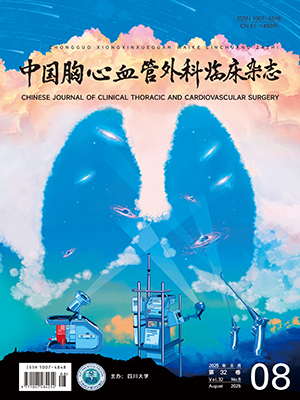| 1. |
Chen F, Wang G. Enhanced recovery after surgery for lung cancer patients. Open Med (Wars), 2020, 15: 198-203.
|
| 2. |
李鹏飞, 赖玉田, 周坤, 等. 应用Clavien-Dindo分级系统对肺癌患者术后并发症分级及危险因素分析. 中国肺癌杂志, 2017, 20(4): 264-271.
|
| 3. |
Fernandez FG, Falcoz PE, Kozower BD, et al. The Society of Thoracic Surgeons and the European Society of Thoracic Surgeons general thoracic surgery databases: Joint standardization of variable definitions and terminology. Ann Thorac Surg, 2015, 99(1): 368-376.
|
| 4. |
中国医师协会胸外科医师分会, 胸外科专业术语标准化委员会. 胸外科疾病标准化诊疗术语. 北京: 人民卫生出版社, 2017. 81-106.
|
| 5. |
Dindo D, Demartines N, Clavien PA. Classification of surgical complications: A new proposal with evaluation in a cohort of 6336 patients and results of a survey. Ann Surg, 2004, 240(2): 205-213.
|
| 6. |
岑磊磊. 结肠癌根治术后并发症的Clavien-Dindo分级及其危险因素分析. 中国现代普通外科进展, 2021, 24(9): 706-710.
|
| 7. |
王少东, 隋锡朝, 杨帆, 等. 早期非小细胞肺癌VATS根治术并发症预测模型的建立—前瞻性多中心研究. 中华胸心血管外科杂志, 2017, 33(2): 87-90, 102.
|
| 8. |
王政. 非小细胞肺癌肺叶切除术后并发症分级及其危险因素分析. 蚌埠医学院, 2020.
|
| 9. |
聂蕴韬. 改良POSSUM评分联合Clavien-Dindo分级预测胸腔镜肺手术术后严重并发症发生率的应用研究. 河北医科大学, 2018.
|
| 10. |
Dai W, Xie S, Zhang R, et al. Developing and validating utility parameters to establish patient-reported outcome-based perioperative symptom management in patients with lung cancer: A multicentre, prospective, observational cohort study protocol. BMJ Open, 2019, 9(10): e030726.
|
| 11. |
Charlson ME, Pompei P, Ales KL, et al. A new method of classifying prognostic comorbidity in longitudinal studies: Development and validation. J Chronic Dis, 1987, 40(5): 373-383.
|
| 12. |
Mayhew D, Mendonca V, Murthy BVS. A review of ASA physical status—Historical perspectives and modern developments. Anaesthesia, 2019, 74(3): 373-379.
|
| 13. |
Goldstraw P, Chansky K, Crowley J, et al. The IASLC Lung Cancer Staging Project: Proposals for revision of the TNM stage groupings in the forthcoming (eighth) edition of the TNM classification for lung cancer. J Thorac Oncol, 2016, 11(1): 39-51.
|
| 14. |
Sawada S, Suehisa H, Ueno T, et al. Changes in post-operative complication and mortality rates after lung cancer resection in the 20-year period 1995-2014. Acta Med Okayama, 2016, 70(3): 183-188.
|
| 15. |
夏琰, 倪铮铮, 杨洁, 等. 胸腔镜肺癌根治术术后并发症及其严重程度的危险因素分析. 中华胸心血管外科杂志, 2013, 29(8): 487-490.
|
| 16. |
Motono N, Ishikawa M, Iwai S, et al. Individualization of risk factors for postoperative complication after lung cancer surgery: A retrospective study. BMC Surg, 2021, 21(1): 311.
|
| 17. |
Suzuki K, Saji H, Aokage K, et al. Comparison of pulmonary segmentectomy and lobectomy: Safety results of a randomized trial. J Thorac Cardiovasc Surg, 2019, 158(3): 895-907.
|
| 18. |
Dai W, Dai Z, Wei X, et al. Early patient-reported outcomes after uniportal vs. multiportal thoracoscopic lobectomy. Ann Thorac Surg, 2021, S0003-4975(21): 01674-X.
|
| 19. |
Wei X, Yu H, Dai W, et al. Patient-reported outcomes of video-assisted thoracoscopic surgery versus thoracotomy for locally advanced lung cancer: A longitudinal cohort study. Ann Surg Oncol, 2021, 28(13): 8358-8371.
|
| 20. |
Dimitrovska NT, Bao F, Yuan P, et al. Learning curve for two-port video-assisted thoracoscopic surgery lung segmentectomy. Interact Cardiovasc Thorac Surg, 2022, 34(3): 402-407.
|
| 21. |
Migliore M, Criscione A, Calvo D, et al. Safety of video-assisted thoracic surgery lobectomy for non-small-cell lung cancer in a low-volume unit. Future Oncol, 2016, 12(23s): 47-50.
|
| 22. |
冀华逊. 非小细胞肺癌术后并发症的危险因素分析. 转化医学电子杂志, 2015, 2(11): 68-69.
|
| 23. |
Pennathur A, Brunelli A, Criner GJ, et al. Definition and assessment of high risk in patients considered for lobectomy for stage Ⅰ non-small cell lung cancer: The American Association for Thoracic Surgery expert panel consensus document. J Thorac Cardiovasc Surg, 2021, 162(6): 1605-1618.
|
| 24. |
Lugg ST, Agostini PJ, Tikka T, et al. Long-term impact of developing a postoperative pulmonary complication after lung surgery. Thorax, 2016, 71(2): 171-176.
|
| 25. |
姜格宁, 张雷, 朱余明, 等. 肺切除手术患者术前肺功能评估肺科共识. 中国胸心血管外科临床杂志, 2020, 27(1): 1-9.
|
| 26. |
Zhang Y, Jheon S, Li H, et al. Results of low-dose computed tomography as a regular health examination among Chinese hospital employees. J Thorac Cardiovasc Surg, 2020, 160(3): 824-831.
|
| 27. |
孙大强, 陈平雁, 刘伦旭, 等. 11958例Ⅰ~ⅢA期非小细胞肺癌手术患者不同随访方式5年生存率比较的多中心真实世界研究. 中国胸心血管外科临床杂志, 2021, 28(6): 615-622.
|
| 28. |
Pompili C, McLennan Battleday F, Chia WL, et al. Poor preoperative quality of life predicts prolonged hospital stay after VATS lobectomy for lung cancer. Eur J Cardiothorac Surg, 2021, 59(1): 116-121.
|




